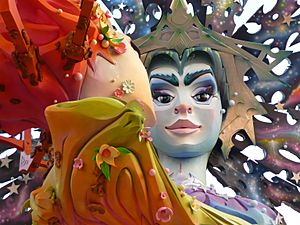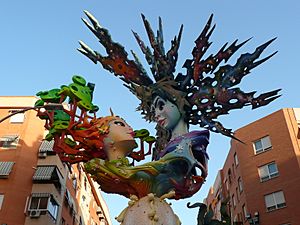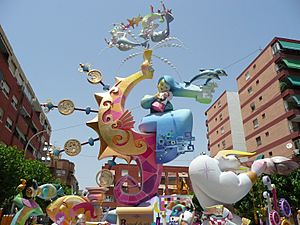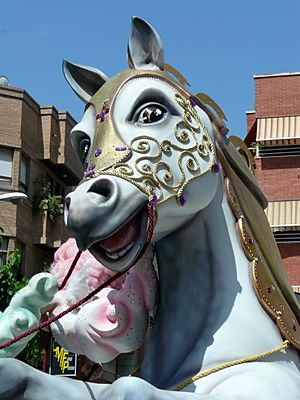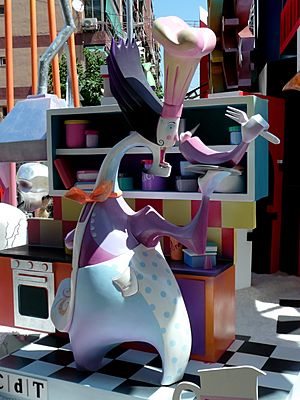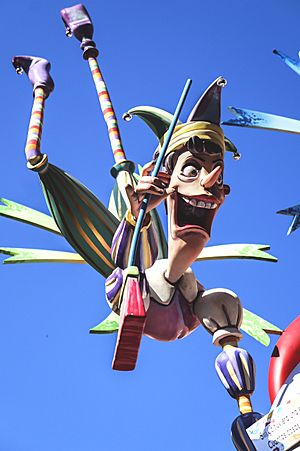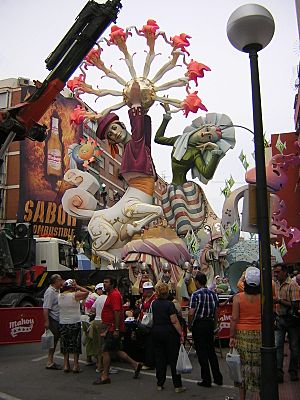Hogueras de Alicante facts for kids
The Bonfires of Saint John (called Hogueras de San Juan in Spanish and Fogueres de Sant Joan in Valencian) are a big, traditional festival in Alicante, Spain. It happens every year from June 19 to 24. This celebration comes from an old tradition of lighting bonfires on Saint John's Eve. Many places, especially along Spain's Mediterranean coast, celebrate with bonfires. In Alicante, it's the most important official festival. It was named a "Fiesta of International Tourist Interest" in 1983 and a "Bien de Interés Cultural" (a special cultural heritage) in 2014.
Contents
What are the Bonfires of Saint John?
The festivals around Midsummer's Eve, also known as St. John's Eve for Christians, have very old roots. They come from ancient celebrations linked to the summer solstice. This is the longest day of the year. People used to light bonfires to protect themselves from evil spirits. They believed these spirits roamed freely when the sun started moving south again. Later, people also thought witches might be out meeting other powerful beings.
Fire is a big part of many of these celebrations. People gather and build huge bonfires using all sorts of wood, like old furniture. They share food and drinks, and sometimes teens and children even jump over the fires! Parties often happen in open areas, like beaches. Here, bonfires are lit, and usually, there are firework displays. Along the Spanish Mediterranean coast, especially in Catalonia and the Valencian Community, special foods like coca de Sant Joan are eaten. In Alicante, since 1928, the Bonfires of Saint John have grown into amazing art pieces. These are inspired by the famous Fallas festival in Valencia.
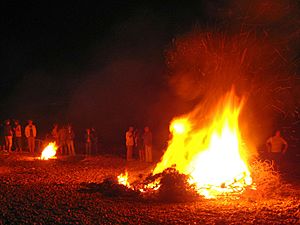
Celebrating in Alicante

How the Festival Started
Before 1928, the bonfires of Saint John were celebrated in Alicante like everywhere else in Europe. People would burn old furniture on the night of Saint John, June 24. The Bonfires festival in Alicante as we know it today began in 1928. Jose María Py, who founded the festival, thought Alicante needed a really big fiesta. He came up with the idea to mix bonfires with an older Valencian tradition called the "fallas".
Main Events of the Festival
The festival is packed with exciting events!
June 19
- The Bonfires officially begin with 'The Set Up' (la plantà). This is when the huge monuments, street figures called ninots, and archways for the "barraques" are put up in the streets. At night, people eat a tuna pie (coca amb tonyina) and early figs (bacores).
June 19–24
- The despertà happens at 8:00 AM. This is when neighbors are woken up with a lot of noise in all parts of the city.
- The mascletà takes place at 2:00 PM. It's a loud show of fireworks combined with a very long string of firecrackers.
- At night, from 11:00 PM to 6:00 AM, there are street parties in all city districts. People dance and drink all night at the "racós" and "barraques."
June 21
- The Street Band Parade (Entrada de bandas) happens at 7:00 PM.
June 22
- At 11:30 AM, the Prize Giving Parade (Desfilada entrega de premios) takes place.
- At 7:00 PM, the Flower Offering Parade for St Mary of the Remedy (Ofrenda de flores a la Virgen del Remedio) happens.
In these parades, people wear traditional clothes from Alicante. In the Flower Offering, women wear a special lace veil called a mantilla and carry bunches of flowers.
June 23
- At 9:00 PM, the International Folklore Parade (Desfile folklórico internacional) takes place.
June 24
- At midnight (early morning of June 25), 'The Palm' (La Palmera) happens. This is a stunning waterfall of fireworks. It's followed by 'The Burning' (La Cremà), which is the grand end of the festival.
Before these main events in June, there are other activities. These include the Ninot and Children's Ninot Exhibition, a Paella Contest, and various parades and ceremonies. After June 24, there's a Firework Display Competition and a String of Firecrackers Display at Postiguet Beach. There are also sports events and a Medieval Street Market.
Throughout the rest of the year, the Bonfires groups host other events. In autumn, there's a music and dance competition. In December, there's a Christmas Carol Competition. In May, the "Beauty of the Fire Contest" (Festival d’elecció de la Bellea del Foc) is held. This is a very important event outside the main festival time.
How the Festival is Organized
The Bonfires are organized into groups called "commissions." These groups raise money and host events all year. A member of a commission is called a foguerer. A commission usually represents one area, place, or street in the city. Some areas have many commissions. For example, Carolinas has five different commissions. In Alicante, there are over 90 commissions, plus many more for children.
A barraca is a group of friends who don't take part in all the activities. They raise money just to eat, drink, and dance during the festival. They do this in a special street spot also called the barraca. A member of a barraca is called a barraquero.
The barracas and racós are places set up in the street. They have tables, chairs, a bar, music, and a dance floor. They are places for people to eat, talk, drink, dance, and socialize during the festival. The main difference is that a racó is for everyone in the district and is free to enter. A barraca has restricted entry. The racó is made by the foguerers, and the barraca is made by the barraquers.
The commissions organize and take part in many events all year. These include artistic competitions, parades, and beauty contests. These activities are open to everyone, and people from the local area often join in. In some areas, like Ciudad de Asís and Carolinas Altas, the bond between the commission and the local residents is very strong.
A big way the festival gets money is through a lottery run by the commissions. They also get money from tombolas, raffles, and sales.
The Beauties of the Festival
The Beauty is a very important symbol of the Bonfires, second only to the monuments. The Beauty is a woman who is chosen as the queen of the festival. There are both Beauties and Infantile Beauties. They represent the main Bonfires and the children's Bonfires.
Since each commission has a Beauty, there are nearly 90 Beauties and many Infantile Beauties in Alicante. A Beauty can have two or four Honour Ladies in her commission.
There are also special Honour Ladies for the whole city. The Beauty of the Fire (Bellea del Foc) is the main queen of the festival for all of Alicante. She has six Ladies of the Fire (Dames del Foc) who help her.
Traditional Clothes
People wear three main types of traditional clothes during the festival:
Novia Alicantina (Alicantinian Bride): This is the costume worn by the Beauties and Honour Ladies. It includes:
- A band in the hair
- A white, round lace veil called a mantilla
- A small bunch of lemon blossoms
- Two hanging earrings
- A cross with jewelry around the neck
- A black, velvet top with long sleeves
- A fan
- A black apron with jewelry
- A long skirt
- A petticoat (sinagües)
- White stockings
- Black heels
Labradora (farmer): This costume is for other women. It includes:
- A band in the hair with flowers
- Two hanging earrings
- A cross with a black ribbon around the neck
- A white piece called a "manteleta"
- A colorful top
- A white apron
- A long skirt, like the Beauties'
- A petticoat (sinagües)
- White stockings
- Black heels
Zaragüelles: This is the costume for men. It includes:
- A scarf worn on the head or around the neck
- A white cotton shirt
- A blanket with pockets
- A long sash in the same color as the scarf
- Full white trousers called "zaragüelles"
- White stockings
- Shoes called "espardenyes"
Art: The Monuments
The Bonfires are a true art show. In autumn, there's an art competition among the Bonfire Commissions. During the festival, you'll see Ninots (wooden figures) in the streets. This is an old tradition that was brought back in 2008. Every year, there's also an Official Festival Poster, which is a beautiful piece of art.
But the most important art in this festival are the Monuments, which are also called Bonfires (Fogueres). They are made from wood, cardboard, mud, and paint. Nowadays, they also use cork and polyurethane. A Bonfire is not just an artistic creation. It's also a way to comment on the social, political, and economic situation of the world, and especially Alicante. These comments are made through the "Ninot" figures. A Ninot often looks like a famous person, usually a funny version of a politician.
The Bonfires are different from the Valencian Fallas. When Bonfires started in Alicante, they were not made by "faller" artists. The first Bonfires were created by local painters and sculptors. They didn't copy the Valencian style. Instead, they were very modern and followed art styles like Art Deco. This modern approach continued throughout the festival's history (except in the 1970s, when the Valencian style was used). Today, Bonfires are still unique.
A Bonfire is paid for by money raised by the Bonfire Commission. They also get donations from local residents and shops. The Monument Competition is the most important contest during the Bonfire events. Monuments are divided into seven groups based on their price. There are 6 categories (from 1st to 6th), and a Special Category. The Special Category includes the most expensive bonfires, costing over 60,100 euros.
Some of the most famous artists in the Bonfire's history include Gastón Castelló and Ramón Marco. The district that has won the most times is Benalúa, with 18 victories. Other successful districts are Ciudad de Asís and Carolinas Altas.
Bonfires are set up on June 20 in an event called "La plantà." They are burned on June 24 in a very beautiful and emotional event called "La cremà" (the burning). "La plantà" marks the start of the Alicante Festival, and "La cremà" marks its end.
See also
 In Spanish: Hogueras de Alicante para niños
In Spanish: Hogueras de Alicante para niños


